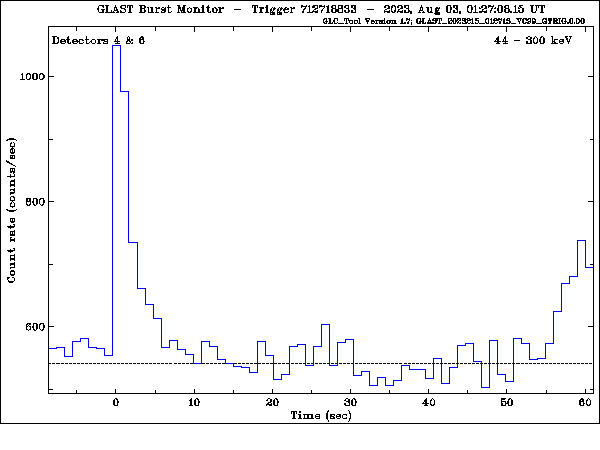(All information courtesy of the instrument teams.)
![]() Previous IAU Circulars
Previous IAU Circulars
TITLE: GCN/FERMI NOTICE
NOTICE_DATE: Thu 03 Aug 23 01:27:38 UT
NOTICE_TYPE: Fermi-GBM Flight Position
RECORD_NUM: 44
TRIGGER_NUM: 712718833
GRB_RA: 145.233d {+09h 40m 56s} (J2000),
145.351d {+09h 41m 24s} (current),
144.982d {+09h 39m 56s} (1950)
GRB_DEC: -67.883d {-67d 52' 59"} (J2000),
-67.991d {-67d 59' 27"} (current),
-67.655d {-67d 39' 17"} (1950)
GRB_ERROR: 5.93 [deg radius, statistical plus systematic]
GRB_INTEN: 431 [cnts/sec]
DATA_SIGNIF: 20.00 [sigma]
INTEG_TIME: 1.024 [sec]
GRB_DATE: 20159 TJD; 215 DOY; 23/08/03
GRB_TIME: 5228.15 SOD {01:27:08.15} UT
GRB_PHI: 273.00 [deg]
GRB_THETA: 60.00 [deg]
DATA_TIME_SCALE: 1.0240 [sec]
HARD_RATIO: 1.05
LOC_ALGORITHM: 3 (version number of)
MOST_LIKELY: 98% GRB
2nd_MOST_LIKELY: 1% Generic SGR
DETECTORS: 0,0,0, 1,1,0, 1,0,0, 0,0,0, 0,0,
SUN_POSTN: 132.95d {+08h 51m 47s} +17.60d {+17d 36' 17"}
SUN_DIST: 86.07 [deg] Sun_angle= -0.8 [hr] (East of Sun)
MOON_POSTN: 332.49d {+22h 09m 56s} -15.95d {-15d 57' 01"}
MOON_DIST: 95.90 [deg]
MOON_ILLUM: 98 [%]
GAL_COORDS: 286.45,-11.34 [deg] galactic lon,lat of the burst (or transient)
ECL_COORDS: 209.01,-69.29 [deg] ecliptic lon,lat of the burst (or transient)
LC_URL: http://heasarc.gsfc.nasa.gov/FTP/fermi/data/gbm/triggers/2023/bn230803061/quicklook/glg_lc_medres34_bn230803061.gif
COMMENTS: Fermi-GBM Flight-calculated Coordinates.
COMMENTS: This trigger occurred at longitude,latitude = 97.35,-6.75 [deg].
COMMENTS: The LC_URL file will not be created until ~15 min after the trigger.
TITLE: GCN/FERMI NOTICE
NOTICE_DATE: Thu 03 Aug 23 01:27:56 UT
NOTICE_TYPE: Fermi-GBM Ground Position
RECORD_NUM: 58
TRIGGER_NUM: 712718833
GRB_RA: 152.280d {+10h 09m 07s} (J2000),
152.443d {+10h 09m 46s} (current),
151.934d {+10h 07m 44s} (1950)
GRB_DEC: -66.300d {-66d 17' 59"} (J2000),
-66.416d {-66d 24' 58"} (current),
-66.054d {-66d 03' 13"} (1950)
GRB_ERROR: 2.60 [deg radius, statistical only]
DATA_SIGNIF: 21.80 [sigma]
DATA_INTERVAL: 2.048 [sec]
GRB_DATE: 20159 TJD; 215 DOY; 23/08/03
GRB_TIME: 5228.15 SOD {01:27:08.15} UT
GRB_PHI: 274.00 [deg]
GRB_THETA: 63.00 [deg]
E_RANGE: 44.032 - 279.965 [keV]
LOC_ALGORITHM: 4173 (Gnd S/W Version number)
SUN_POSTN: 132.95d {+08h 51m 47s} +17.60d {+17d 36' 16"}
SUN_DIST: 85.28 [deg] Sun_angle= -1.3 [hr] (East of Sun)
MOON_POSTN: 332.49d {+22h 09m 57s} -15.95d {-15d 56' 57"}
MOON_DIST: 97.63 [deg]
MOON_ILLUM: 98 [%]
GAL_COORDS: 287.61, -8.39 [deg] galactic lon,lat of the burst (or transient)
ECL_COORDS: 208.44,-66.13 [deg] ecliptic lon,lat of the burst (or transient)
LC_URL: http://heasarc.gsfc.nasa.gov/FTP/fermi/data/gbm/triggers/2023/bn230803061/quicklook/glg_lc_medres34_bn230803061.gif
POS_MAP_URL: http://gcn.gsfc.nasa.gov/notices_f/gbm_gnd_loc_map_712718833.fits
COMMENTS: Fermi-GBM Ground-calculated Coordinates.
COMMENTS: This Notice was ground-generated -- not flight-generated.
COMMENTS: The LC_URL file will not be created/available until ~15 min after the trigger.
COMMENTS: The POS_MAP_URL file will not be created/available until ~1.5 min after the notice.
TITLE: GCN/FERMI NOTICE
NOTICE_DATE: Thu 03 Aug 23 01:36:36 UT
NOTICE_TYPE: Fermi-GBM Final Position
RECORD_NUM: 0
TRIGGER_NUM: 712718833
GRB_RA: 158.410d {+10h 33m 38s} (J2000),
158.612d {+10h 34m 27s} (current),
157.984d {+10h 31m 56s} (1950)
GRB_DEC: -64.380d {-64d 22' 47"} (J2000),
-64.502d {-64d 30' 07"} (current),
-64.122d {-64d 07' 16"} (1950)
GRB_ERROR: 3.33 [deg radius, statistical only]
GRB_DATE: 20159 TJD; 215 DOY; 23/08/03
GRB_TIME: 5228.15 SOD {01:27:08.15} UT
GRB_PHI: 275.00 [deg]
GRB_THETA: 66.00 [deg]
E_RANGE: 44.032 - 279.965 [keV]
LOC_ALGORITHM: 41731 (Gnd S/W Version number)
SUN_POSTN: 132.95d {+08h 51m 49s} +17.60d {+17d 36' 11"}
SUN_DIST: 84.44 [deg] Sun_angle= -1.7 [hr] (East of Sun)
MOON_POSTN: 332.58d {+22h 10m 18s} -15.91d {-15d 54' 48"}
MOON_DIST: 99.45 [deg]
MOON_ILLUM: 97 [%]
GAL_COORDS: 288.71, -5.38 [deg] galactic lon,lat of the burst (or transient)
ECL_COORDS: 207.88,-62.94 [deg] ecliptic lon,lat of the burst (or transient)
LC_URL: http://heasarc.gsfc.nasa.gov/FTP/fermi/data/gbm/triggers/2023/bn230803061/quicklook/glg_lc_medres34_bn230803061.gif
LOC_URL: http://heasarc.gsfc.nasa.gov/FTP/fermi/data/gbm/triggers/2023/bn230803061/quicklook/glg_locplot_all_bn230803061.png
COMMENTS: Fermi-GBM Final Position.
COMMENTS: This Notice was ground-generated -- not flight-generated.
COMMENTS: The LC_URL file should be available by the time this FINAL notice is produced.
COMMENTS: This notice was generated completely by automated pipeline processing.
COMMENTS: This is likely a Long GRB.

--------------------------------------------- RA(2000), deg Dec(2000), deg --------------------------------------------- Center: 150.510 (10h 02m 02s) -64.987 (-64d 59' 12") Corners: 147.455 (09h 49m 49s) -64.554 (-64d 33' 15") 147.329 (09h 49m 19s) -64.581 (-64d 34' 51") 153.688 (10h 14m 45s) -65.347 (-65d 20' 50") 153.812 (10h 15m 15s) -65.315 (-65d 18' 54") ---------------------------------------------The error box area is 431 sq. arcmin, and its maximum dimension is 2.8 deg (the minimum one is 3 arcmin). The Sun distance was 83 deg.